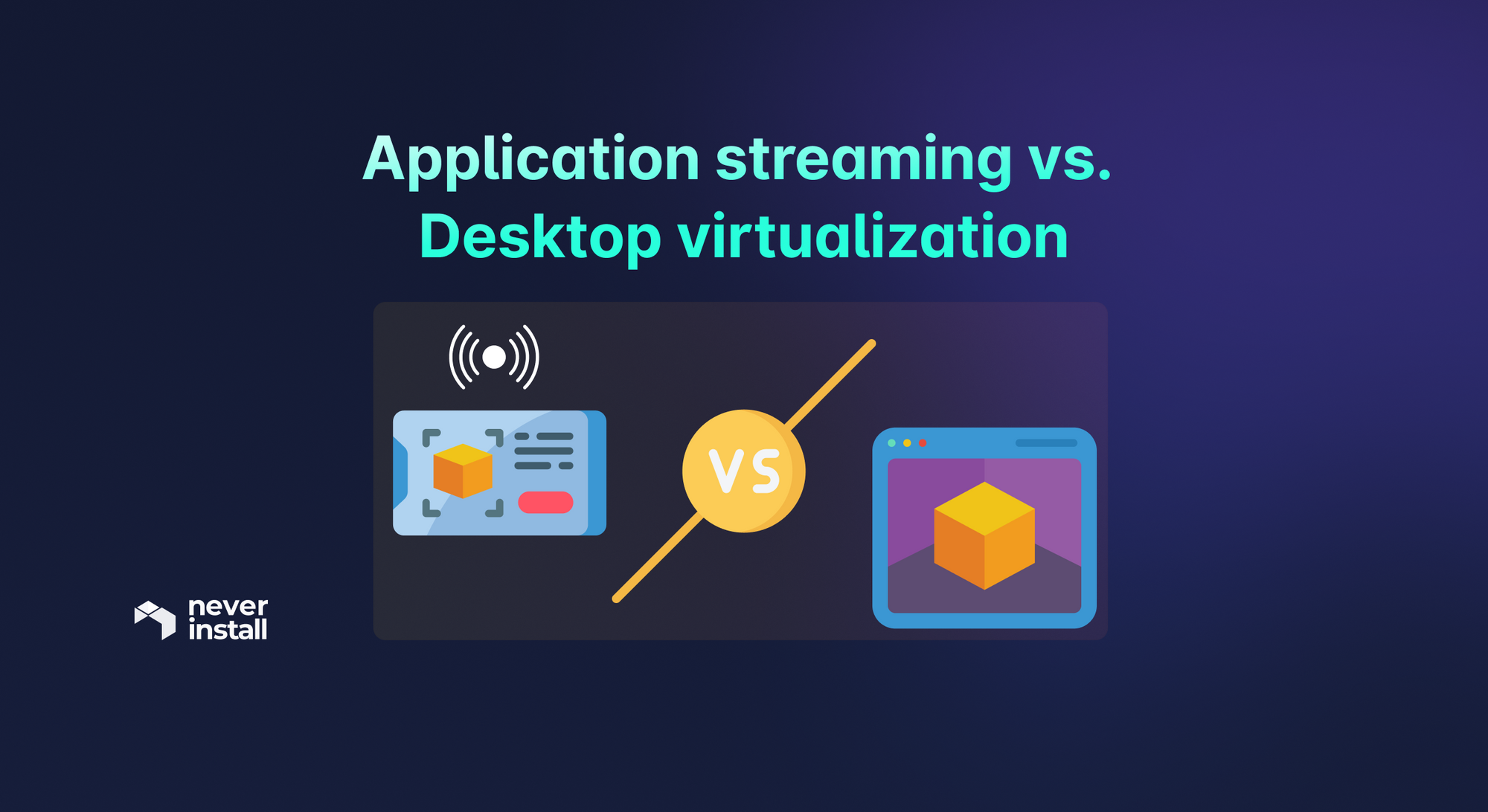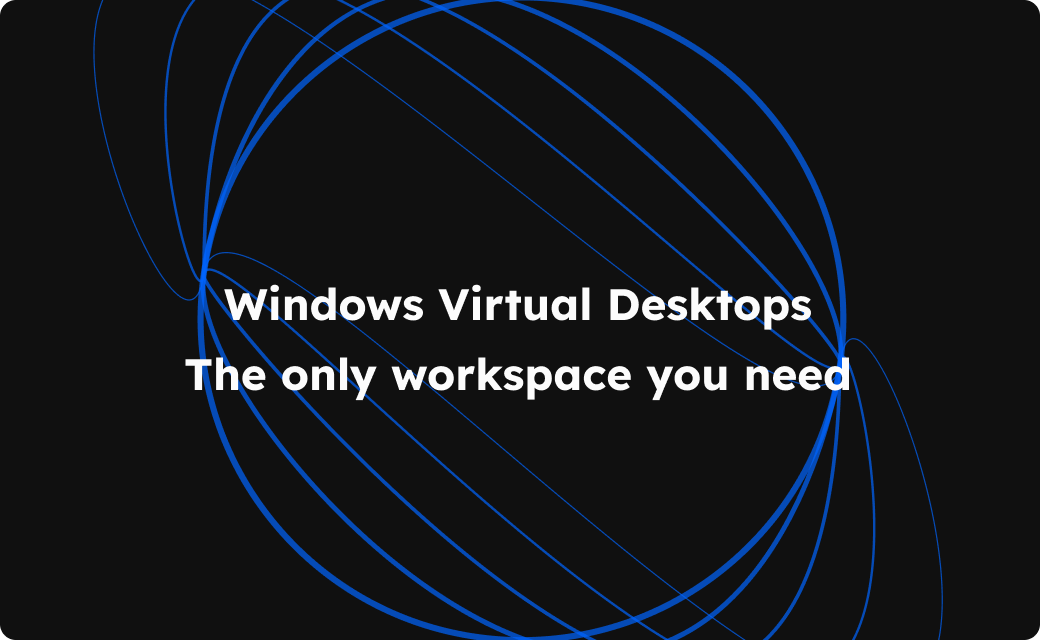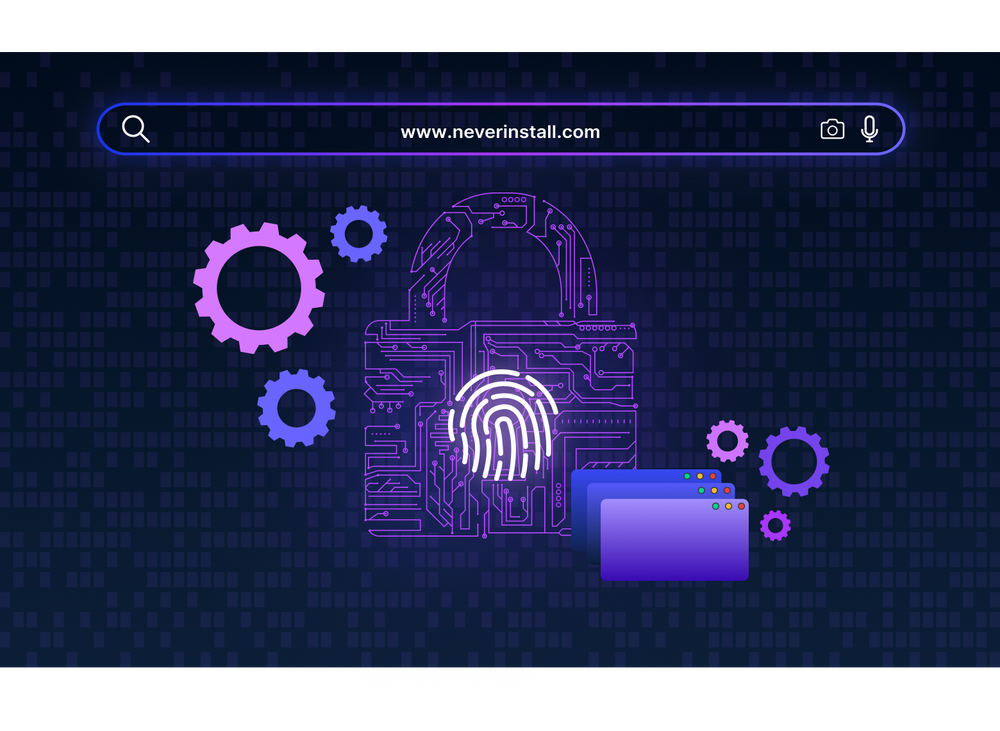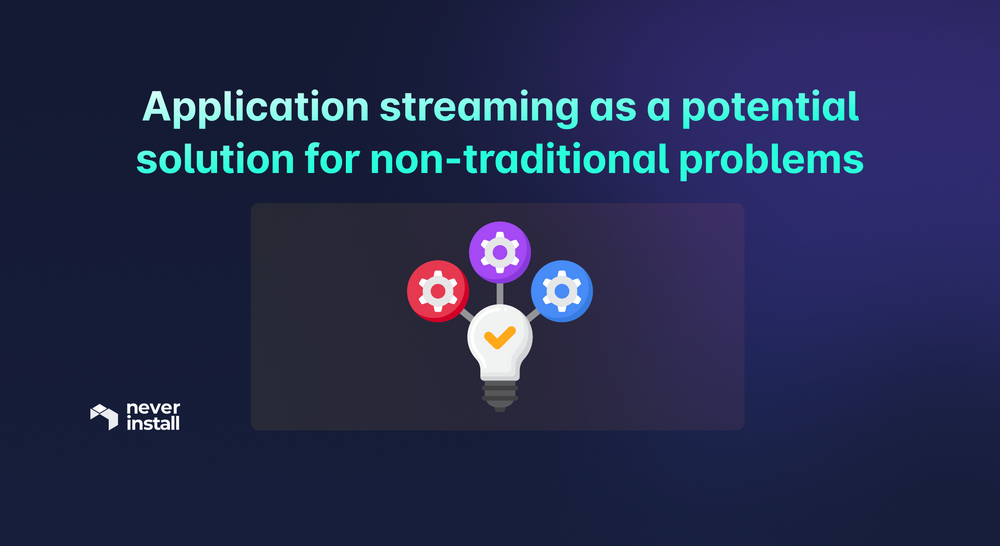The rise of remote work has prompted organizations to actively revamp their toolset to facilitate remote access to their data and apps. However, since employees join work from multiple locations (global and regional), they have taken to accessing work data and requisite tech via their personal devices, which has raised additional concerns about security and data privacy.
Among the emergent technologies to help with these requirements, application streaming and desktop virtualization have particularly stood out. Both have emerged as battle-tested methods of enabling access to the tools required for day-to-day employee activities, including using resource-heavy design suites and IDEs.
In this article, we’ll take a cursory look at both these technologies and explore some key differences between the two so that you can make a more informed choice about which practice resonates with your team or organizational needs.
What is application streaming?
Application streaming allows users to access desktop-class applications through a browser. In this case, a device accesses apps hosted on a remote server via the cloud. The experience is similar to streaming Netflix videos, except you can interact with apps, tools, and a virtual desktop to accomplish tasks similar to an OS on your native machine.
In its simplest and most elegant form, app streaming lets users access a personal cloud desktop, equipped with everything required for a native desktop experience, entirely over the internet.
A big differentiator is that, in application streaming, the local device used to access the apps does not undertake the operational overhead of running the online desktop or apps. That responsibility lies with the remote server, on which all apps are pre-installed and pre-configured.
Leveraging application streaming allows you to run the most resource-consuming apps on personal devices with basic hardware and software capabilities, such as Chromebooks. All the device needs is an internet connection (with reasonable speeds) and an internet browser. The advantage of this feature is immediate and massive, i.e., user productivity is no longer dependent on their endpoint.
Suggested read: Application streaming: Where it has taken us
Benefits of Application Streaming
- Companies no longer need to issue and ship thousands of devices to their employees. They can simply provide credentials to the app streaming portal, which the employee can access from their own devices.
- Power users like devs and designers can use IDEs, collaboration apps, design tools, and other heavy apps without needing an expensive device with high processing capabilities.
- IT security teams can get single-panel control over the app streaming portal. Anytime a device is lost/stolen/misplaced, they can simply disable those particular credentials or block access from a particular device eliminating all risk of exposing corporate data.
- Security patches and updates no longer have to be applied to individual endpoints, just the app streaming platform - much easier to do since you can implement them remotely.
- Every employee’s digital setup becomes accessible remotely and is device-agnostic. Consequently, IT costs (especially for vendor support) reduce. Coupled with the fact that heavy apps can be streamed and run without buying expensive endpoints, this significantly lowers TCO.
Suggested read: Familiar in the Cloud: Streaming the native desktop experience to your browser
What is desktop virtualization?
Fundamentally, desktop virtualization provides the same feature as app streaming - access to a remote desktop independent of compatibility with the local device. It replaces dependence on the physical device with one or more remote computing environments. However, in this case, all computing components of a desktop are hosted virtually to simplify optimal functioning, management, and resource usage.
Providers host these virtualized desktops on virtual desktop infrastructure or VDI - the bedrock technology required to offer, run and manage remote desktop instances. They are hosted on centralized servers and can be deployed to end-users endpoints as required.
The aforementioned centralized servers contain desktop images. A hypervisor splits the server into these images that users can, in turn, utilize through their endpoints. The VDI provider makes these desktop images available to an organization’s IT team, who can further shape it as they see fit - install necessary apps, institute limitations on the data they can access, set up mechanisms to monitor traffic, etc. Once configured, these desktops are made available for employees, who can access them via any device as long as they have the requisite login credentials.
The VDIs, too, can be persistent or non-persistent.
Persistent VDIs act closely like a personal desktop/laptop experience. With the former, the user accesses the same desktop (with saved versions of their previous work/app usage) every single time. In this case, the provider allows users to personalize their desktop to save all changes before a connection resets.
Non-persistent VDIs are the opposite. They provide generic desktops where users cannot save changes, and the system resets after a user logs out. Users cannot customize these desktops, and the providers do not maintain their state between sessions. Non-persistent VDIs are simpler, cheaper to initiate, and useful for teams or organizations with multiple individuals who perform repetitive tasks, not necessarily needing to save a session.
At its core, desktop virtualization converts entire desktops, including installed apps, tools, browsers, and files, into virtually-accessible, cloud-based, device-independent functional clusters.
Primarily, virtualized desktops are deployed by major organizations that want significant control over employees’ digital work environment, particularly their interaction with company data. VDI providers also customize said desktops with relevant capabilities and safeguards to make them suitable for tasks required by an employee’s industry, role, and corresponding access level.
Benefits of Desktop Virtualization
As the list below will depict, some benefits of desktop virtualization mirror those offered by app streaming, while others are more unique:
- Desktop virtualization enables remote access from any location or device.
- Provides customized desktops for multiple teams (disparate requirements) across an organization, reducing the time, effort, and money companies would otherwise spend to do the same in-house.
- Provides device-agnostic performance - making it possible to run heavy apps on basic devices.
- Makes it possible to get work done with cheaper devices - cost savings for the company.
- Lowers the cost of device maintenance and repair since the device does not suffer the wear and tear of running said heavy apps.
- All corporate data resides on the server rather than the endpoint, thus ensuring increased security and closer control over data usage.
- Easy to institute role-based access control by configuring an employee’s desktop so that it can only access the data they require at their level of seniority and security clearance.
- IT teams can easily patch, update or configure all virtual desktops in a network.
- IT teams can easily delete desktop instances of employees who leave, spin up new instances within minutes, or scale up the total number of virtual desktops if required.
- Can provide completely customized desktops (OS, apps, storage capability, data security guardrails) designed to cater solely to the requirement and preferences of specific teams within particular organizations.
Application streaming vs. Desktop Virtualization
So, wherein lies the difference? Why and how should you pick one over the other to help with your remote team’s tech requirements?
Setup Effort: App streaming enables access to pre-installed apps.
That’s the whole point of the exercise - enabling users to access apps over the cloud without downloading, setting up, and configuring anything. An app streaming platform doesn’t require users to install anything; they simply select the apps they wish to use, and those appear pre-installed, pre-configured, and ready to use when the user launches them.
Customers of VDI providers, usually enterprises, however, do not (generally) have the privilege of leveraging pre-installed apps. The provider offers virtual desktop images equipped with specified computing capabilities - RAM, GPU, storage space, bandwidth, etc. - as requested by the customer.
However, once the virtualized desktops are made available, required apps, security partitions, access control managers, and other software configurations must be implemented by the customer’s (the enterprise) IT personnel. So, unlike app streaming, desktop virtualization cannot simply be triggered and operational in seconds. It requires a non-trivial amount of setup effort because it can be useful for employees.
In other words, desktop virtualization provides the infrastructure to use the software a team needs, regardless of device capabilities. While VDI will provide the backbone for it, the utilization of computing resources for setup/scaling/configuration lies entirely with the in-house IT folks.
Scaling: App streaming platforms are easily and flexibly scalable.
Since teams of varied sizes have gone remote and yet continue to hire, such platforms are the best possible solution for growing teams that don’t want to spend time and money on in-house IT efforts when hiring new people.
In other words, it doesn’t matter if your team has five people or fifty; app streaming is equally useful. As your team grows, you simply scale up by triggering more workspaces, all of which come with pre-installed apps.
Learn more: Elaborate Engineering with Neverinstall: Reactive and pre-emptive scaling
VDI providers, especially the market leaders, almost always cater to the infrastructural requirements of enterprise-level clients. Mostly, they won’t be catering to five or even fifty-person teams. Deploying virtualized desktop instances, extending customer support, and establishing configuration and cybersecurity protocols for small teams would be a massive resource sink for the provider, even if they could.
Simultaneously, purchasing such services for only a few employees is prohibitively expensive for smaller organizations. And perhaps completely unfeasible for small or mid-sized teams in the first place.
Due to the infra they provide, virtualized desktop vendors tend to work with customers who require a minimum threshold of desktop instance/infrastructure volume. This qualifying number of endpoints is usually within the mid-to-high range, which makes VDI a non-option for smaller clients. Their scalability and flexibility only kick in for customers who can start with a significant number of endpoint users in the first place.
Closing thoughts
As the descriptions and comparisons above reveal, the question of “when to use which?” between app streaming and desktop virtualization depends entirely on what you want to achieve with a remote work solution. When making that decision, ask yourself a few questions:
- Is your team large enough and adequately funded to approach VDI providers?
- Does your team require highly customizable desktops with RBAC?
- Does your IT team have the bandwidth/personnel/resources to set up/configure virtual desktops from scratch?
- Does an app streaming platform already provide your team's required apps in a pre-installed, pre-configured form? And if so, would this be a simpler, cheaper option to start with?
- What specific features are you looking for in your virtual workspace regarding data security, usability, performance, stability, speed, and accessibility?
Upon answering these questions, you should understand your team’s requirements and the corresponding remote work technology that would serve it best. Given that app streaming and desktop virtualization share the fundamental philosophy of making top-shelf tech available over the cloud, they help achieve many of the same goals. Therefore, you can choose the more financially prudent solution (to start with) without missing out on too many of the features provided by the other option.
Still confused? Sign up on Neverinstall to experience unparalleled application streaming, or contact us at [email protected] and let us help you with your needs!
Author: Shreya Bose
Shreya is a seasoned tech writer. Apart from technology, she loves writing about healthcare, heavy metal, alcohol, and coffee. When she is not writing, she is reading, drinking tea, and waiting for naptime.







